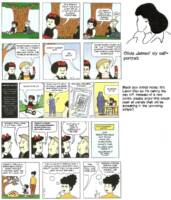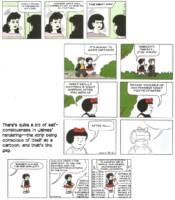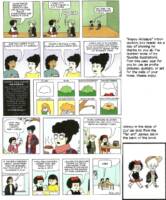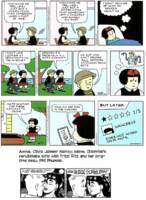Funnies Farrago on Nancy
Eight-year-old Nancy started her cartoon life as a bit player in Ernie Bushmiller’s Fritzi Ritz comic strip, but she was so popular with readers—and with Bushmiller— that she eventually took over the strip. Then, after Bushmiller’s death, the strip’s circulation slowly slipped away. And now, it’s growing by leaps thanks to its new illuminator, Olivia Jaimes.
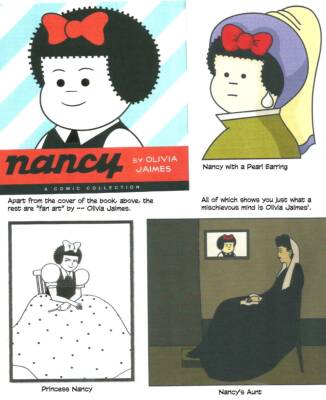 Nancy, a slot-nosed frizzy-haired little girl with a fireplug physique, arrived in the strip on January 2,1933. Bushmiller said that he’d planned to keep her around for a week or so and then “dump her,” as he said, “—but the little dickens was soon stealing the show,” and in 1938, Bushmiller surrendered to the obvious, and on October 30, he renamed the strip after the interloper. By then, Fritzi had pretty much faded from sight.
Nancy, a slot-nosed frizzy-haired little girl with a fireplug physique, arrived in the strip on January 2,1933. Bushmiller said that he’d planned to keep her around for a week or so and then “dump her,” as he said, “—but the little dickens was soon stealing the show,” and in 1938, Bushmiller surrendered to the obvious, and on October 30, he renamed the strip after the interloper. By then, Fritzi had pretty much faded from sight.
Bushmiller did the strip until he died August 15, 1982 (albeit assisted in the last years by Will Johnson). Nancy was then continued by several other cartoonists. The Sunday Nancy was produced by Al Plastino until 1984; the daily, by Mark Lasko (August 29, 1982 – July 9, 1983); then Jerry Scott, the co-creator of Zits and Baby Blues, took it all on (July 11, 1983 – September 2, 1995) until it was taken over by Guy (and Brad) Gilchrist (September 3, 1995 – February 18, 2018) with Guy eventually the sole author until he stepped down in February 2018.
Gilchrist’s last strip was a Sunday, and that day, Fritzi, who had appeared only occasionally through the years since 1933, married, finally, her long-suffering beau, Phil Phumble, who looks pretty much the way you’d expect with a name like that. He’s an authentic nebbish whose luck with the statuesque Fritzi gives hope to all us nebbishes.
After a two-month hiatus (reruns?), Nancy returned with the byline Olivia Jaimes, a pen name, on April 9, 2018, marking the first (and only, so far) time that Nancy has been rendered by a cartoonist of the same gender persuasion, who will doubtless offer a “21st-century female perspective,” says John Glynn, president and editorial director of Andrews McMeel, the distributing syndicate.
“Nancy has been my favorite sassy grouch for a long time,” Jaimes said in a syndicate release. “I’m excited to be sassy and grouchy through her voice instead of just mine, and I can complain to the whole world about things that bother me instead of just to my friends and family.”
The strip’s circulation peaked during the 1970s, running in about 880 newspapers, before slipping to just 79 on the eve of Gilchrist’s departure. The most controversial of Nancy’s run was Scott’s: he “modernized” the appearance of the characters, and faithful readers didn’t warm to the new, more abstracted look. But when Jaimes came aboard and altered the fundamental nature of the strip, applause broke out in hundreds of thousands—mostly among new fans. Since Jaimes has been doing Nancy, the number of subscribing newspapers has doubled, to 156 at last official (“syndicate”) count. And still counting.
The strip enjoys a unique fandom among some professional cartoonists, who hold up examples of the strip at midcentury as a apogee of formal minimalism, giving Nancy a cult status, which is celebrated in the recent book, How to Read Nancy: The Elements of Comics in Three Easy Panels, by Paul Karasik and Mark Newgarden.
“There’s something warm and silly and magical in the facial expressions, the rhythm and the body language,” Glynn said to Michael Cavna at the Washington Post’s Comics Riffs. “Olivia is channeling Ernie Bushmiller while giving it her own unique, 21st-century voice. I think the fates led us to Olivia,” he added about Jaimes, who previously worked in webcomics. “She’s got the gift.”
Not everyone agrees, and Jaimes is getting feedback accordingly. Older (lifelong) fans aren’t quite so sure about the new Nancy, and social media has been a hotbed of controversy between old fans and new.
“Olivia must be channeling her inner Bushmiller,” wrote one positive commenter on the syndicate’s website. Another noted how Jaimes nods to the comic’s tradition even while including modern touches, writing: “It is refreshing to see a return to its original style and humor.” And wrote another: “Nancy Goes Millennial.”
Others have not been as pleased. One critic wrote: “This is ridiculous. You’d never catch Ernie Bushmiller doing a joke about Snap Chat. Bring back, Ernie!” Another reader said to the Washington Post, “Since the characters have not aged in 85 years I don’t think it’s necessary to change them now.”
Jaimes had forewarned readers that her version of the strip would bring technological change. Now, she says, “Nancy’s going to use all the social media and technology I use. People will be able to figure out exactly how behind the times I am by watching what apps she’s using,” continued, Jaimes, who is in her 20s. “It took me until last month to try Spotify, so that should give you an idea of where I’m at.”
Several weeks into her Nancy, how did she feel about the massive reaction — did all the feedback affect her?
“It’s exciting, but since I’ve also been avoiding the Internet a lot lately, it’s not changed my approach or perspective much,” said Jaimes, adding that she hasn’t yet seen the reader comments and has stayed off all social media since her launch.
Jaimes brings a love for the vintage Bushmiller work to her Nancy, Glynn says, but with a voice that he hopes will resonate today.
Overnight, Nancy was more irreverent and modern, at home in the world of cell-phones and the Internet. One of Jaimes’ early strips (Labor Day, 2018) asserted that Sluggo, Nancy’s friend from the other side of the tracks, was “lit,” deploying a scrap of jargon that means “exciting” (more or less).
That strip and the rest of Jaimes’ first nine months are reprinted in Nancy (144 8×8-inch pages, color; 2019 United Feature Syndicate, $14.99), which includes an introduction by Nancy’s editor, Shena Wolf, an appreciation by Hilary B. Price (Rhymes with Orange comic strip), a November 2018 interview with Jaimes, published initially on Vulture.com, and some “fan art” of Nancy drawn by Jaimes (who also includes a self-portrait, which is slyly unrevealing).
Most articles about the Jaimes Nancy make much of the cartoonist being the first woman to draw the strip in its 82-year run. This, of course, is feminist folderol. We can’t know for sure who “Olivia Jaimes” is: a man could have a female pen name. (But probably, in this case, not.)
Jaimes made a “live” appearance at the Cartoon Crossroads Columbus event a year or so ago, but she went to great lengths to disguise herself—wearing a hoodie, a scarf, and dark glasses. Dunno if she was wearing a dress or slacks, but her disguise would have concealed the vital fact of her gender regardless.
Jaimes’ Nancy is, as the cartoonist says in the Vulture.com interview, “a total jerk and also gluttonous and also has big feelings and voraciously consumes her world.” Her Nancy is wholely unapologetic. If she sleeps late or eats too much bread and starts thinking she’s “the worst person in the world,” her next thought is, “So what? Who cares? I don’t care.”
She wants “to grab life by the shoulders and shake it violently.” Sluggo, on the other hand—Nancy’s lifelong companion and annoyance—is “more passive and more go-with-the-flow.”
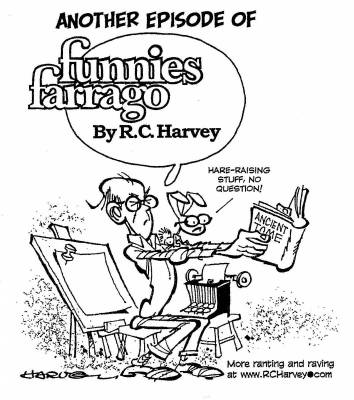 Jaimes has introduced a raft of new characters—Nancy’s teacher, a classmate, and more—and Aunt Fritzi has been revived to assume a conspicuous role. (Fritzi, oddly, isn’t married in the Jaimes incarnation: Gilchrist’s final gesture apparently didn’t “take.”)
Jaimes has introduced a raft of new characters—Nancy’s teacher, a classmate, and more—and Aunt Fritzi has been revived to assume a conspicuous role. (Fritzi, oddly, isn’t married in the Jaimes incarnation: Gilchrist’s final gesture apparently didn’t “take.”)
The cartoonist is producing an increasingly popular comic strip, and she surely knows her craft, but not to hear her tell it: “The writing of Nancy and the drawing of Nancy are such different skills for me,” she said.
Most cartoonists realize that “writing” and “drawing” are one and the same in cartooning. Jaimes doesn’t. Yet. But her work shows she instinctively understands.
Jaimes’ Nancy is highly visual: the gags, as they did with Bushmiller, almost always depend upon some visual element. Bushmiller reportedly conjured up gags by browsing the Montgomery Ward catalogue, stopping frequently to ponder how a shovel or a striped sweater could be made into a gag.
Now, we hang a brief gallery of Jaimes’ strip to show how masterfully she’s mastered the medium— apparently without knowing it.
- Funnies Farrago Celebrates a Half Century of Doonesbury - June 1, 2022
- Who Really Invented the Comic Character ‘Archie’? - May 7, 2022
- Dick Wright Returns - April 5, 2022

